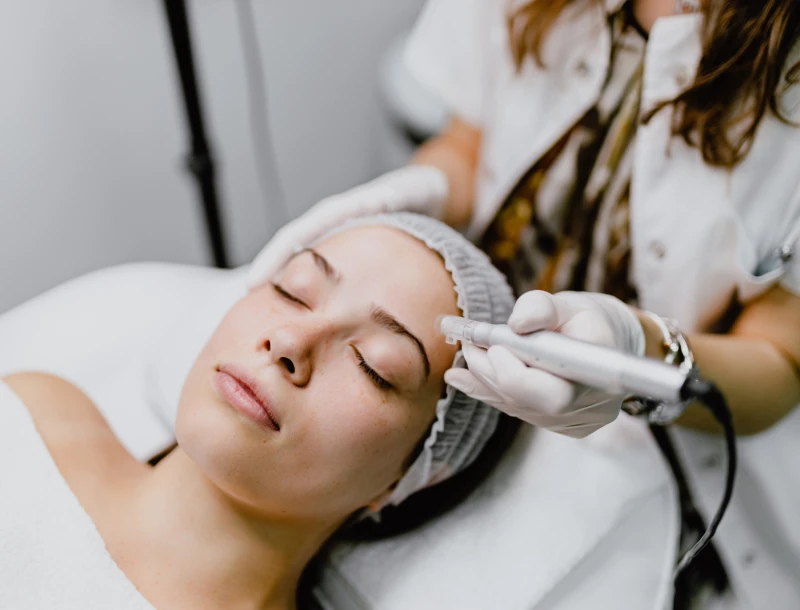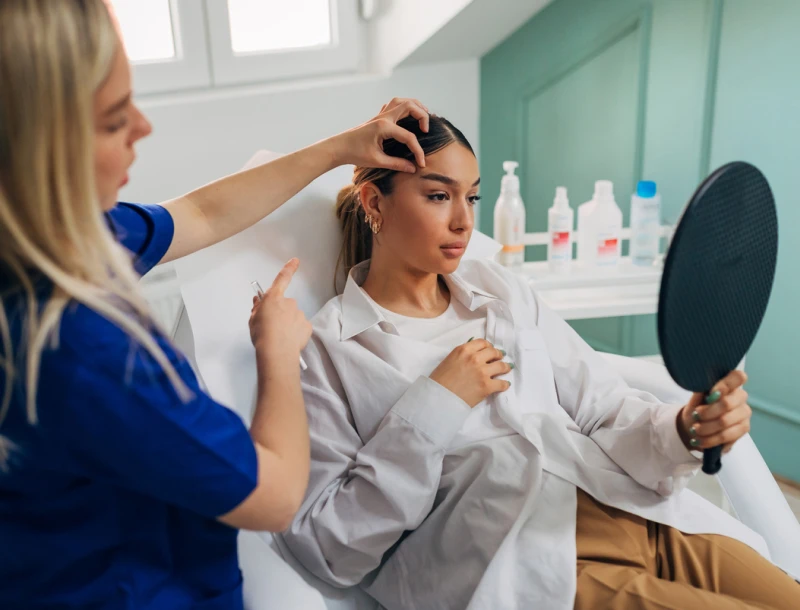The scaffold acts as a template for tissue growth, providing a three-dimensional structure for cells to attach to and proliferate on. Scaffolds can be made from a variety of materials, including synthetic polymers, natural polymers, and composites.
Synthetic polymer scaffolds, such as poly(lactic acid) (PLA) and polydioxanone (PDO), are often used in tissue engineering because they can be made to specific sizes and shapes and have predictable degradation rates.
Natural polymer scaffolds, such as collagen and chitosan, are also used because they are biocompatible and can support cell adhesion and growth.
Composites, which combine natural and synthetic materials, can have enhanced mechanical properties and biocompatibility.
Discover the latest advancements in PLLA Sculptra, PDO threads, and other innovative treatments by scheduling a consultation at CosMedic Laser MD.
Synthetic Polymer Scaffolds
Synthetic polymer scaffolds offer highly tunable properties, enabling customization for specific tissue engineering applications.
Their consistent physicochemical properties and biocompatibility make them suitable for large-scale manufacturing. However, synthetic polymers often lack the bioactive cues necessary for promoting cell adhesion and growth.
Concerns about degradation rates and environmental impact present challenges for their use.
Natural Polymer Scaffolds
Natural polymer scaffolds exhibit inherent bioactivity, biodegradability, and biocompatibility due to their origin from natural sources.
These properties make them highly suitable for tissue engineering applications. However, natural polymers often have variable properties and limited mechanical strength, making it difficult to achieve consistent results for large-scale production.
Composite Scaffolds
Composite scaffolds combine the advantages of both synthetic and natural polymers, providing synergistic properties that include improved mechanical strength, bioactivity, and biocompatibility.
By customizing the ratio and composition of materials, composite scaffolds can be tailored to suit specific tissue engineering applications. The incorporation of natural polymers enhances cell adhesion, proliferation, and differentiation, while the synthetic component provides structural support.
However, challenges with composite scaffolds include their complexity in manufacturing, achieving strong interfaces between components, and potentially higher costs due to the use of multiple materials.

Scaffold Structure, Pore Size, and Surface Properties on Tissue Growth
Scaffold structure, pore size, and surface properties play crucial roles in determining the success of tissue engineering and regeneration.
These factors affect cell behavior, tissue growth, and integration with the host tissue.
Scaffold structure
The structure of a scaffold dictates its mechanical strength and stability. A well-designed scaffold structure should provide adequate support for the growing tissue, while allowing for nutrient and waste exchange.
Scaffolds must replicate the natural ECM for successful cell adhesion, proliferation and differentiation. Porosity and interconnectivity of pores are key for cell migration and vascularization, two essential processes for tissue growth and development.
Pore size
Pore size significantly influences cell behavior and tissue growth. Optimal pore size allows for efficient cell migration, nutrient diffusion, and waste removal.
Pores that are too small may restrict cell infiltration and nutrient transport, limiting tissue growth. Conversely, pores that are too large may compromise mechanical strength and lead to poor cell-cell interactions.
The ideal pore size varies depending on the target tissue type and desired properties.
Generally, pore sizes in the range of 100-500 micrometers have been found to support cell infiltration and tissue ingrowth.
Surface properties
The surface properties of a scaffold, such as surface chemistry, topography, and wettability, impact cell attachment, spreading, and differentiation.
Surface chemistry can be modified to incorporate bioactive molecules, such as peptides or growth factors, to enhance cell adhesion and signaling. Surface topography, including roughness and pattern, can also be engineered to mimic the native ECM and guide cell behavior.
Wettability, or a liquid’s affinity for a surface, affects cell adhesion and spreading. Hydrophilic surfaces generally favor cell attachment, while hydrophobic surfaces can inhibit it.

Benefits of PLLA Sculptra and PDO Threads in Anti-Aging Treatments
As we age, the search for effective and minimally invasive anti-aging treatments becomes more important. Two popular options, PLLA Sculptra and PDO threads, offer unique benefits in improving the appearance of wrinkles, fine lines, and sagging skin while stimulating collagen production for enhanced skin texture and tone.
PLLA Sculptra
PLLA Sculptra is a type of poly-L-lactic acid (PLLA) that is used in dermal fillers to stimulate collagen production and improve the appearance of wrinkles and fine lines.
Sculptra is not a filler, but a collagen stimulator that works by stimulating the body’s own collagen production over time. PLLA is a biodegradable and biocompatible material that has been used in medical procedures for over 30 years.
PLLA Sculptra is injected into the skin using a needle and can be used to treat multiple areas of the face, including the cheeks, temples, and chin.
PDO threads
PDO threads are a type of suture made from polydioxanone (PDO) that are used in thread lift procedures to lift and tighten sagging skin.
PDO threads are biodegradable and stimulate collagen production, which can improve skin texture and tone. There are three types of PDO threads: mono threads, cog threads, and screw threads.
| Thread Type | Description |
| Mono | Smooth sutures that stimulate collagen production and improve skin texture. |
| Cog | Threads with barbs that provide support and lift to the face. |
| Screw | Intertwined threads used to restore volume to sunken areas of the skin. |
PDO threads are less invasive than traditional facelift surgery and can be performed in under 45 minutes.
They have a lower risk of complications than facelift surgery, with minor complications occurring in 15 to 20 percent of procedures. PDO threads can be used in conjunction with other anti-aging procedures, such as dermal fillers to achieve optimal results.
PLLA Sculptra and PDO Threads: Procedure Details and Considerations
Before deciding on PLLA Sculptra and PDO thread treatments, it is important to understand the procedure, treatment frequency, duration of results, and potential side effects or risks involved.
Typically, PLLA Sculptra treatments require two to three sessions spaced several weeks apart for optimal results. The effects of Sculptra can last up to two years, while PDO thread results may last between 6 to 12 months, depending on the individual and the treatment area.
Some potential side effects of PLLA Sculptra and PDO threads include mild discomfort, swelling, bruising, and redness at the injection or insertion sites.
These side effects are usually temporary and subside within a few days. In rare cases, more serious complications may occur, such as infection or thread migration. It is crucial to choose an experienced and qualified professional for these procedures to minimize the risks and ensure the best possible outcomes.
Take the Next Step in Your Anti-Aging Journey
Ready to explore PLLA Sculptra, PDO threads, or other anti-aging treatments further? Consult with a qualified professional to discuss your concerns and goals, and begin your journey towards a more youthful and rejuvenated appearance.
Comparing PLLA Sculptra and PDO Threads with Alternative Anti-Aging Treatments
When considering anti-aging treatments, it is important to explore all available options and compare their effectiveness, risks, and costs. Aside from PLLA Sculptra and PDO threads, other popular treatments include laser resurfacing, chemical peels, and Botox injections.
Laser resurfacing involves using a laser to remove the outer layers of skin, stimulating collagen production and revealing smoother, younger-looking skin beneath.
While effective for improving skin texture and reducing wrinkles, laser resurfacing may require multiple sessions and has a higher risk of side effects, such as scarring or pigmentation changes.
Chemical peels involve applying a chemical solution to the skin, causing it to exfoliate and eventually peel off, revealing a smoother and more radiant complexion. Chemical peels vary in strength and can address various skin concerns, like fine lines, wrinkles, and uneven pigmentation.
However, they may cause temporary redness and irritation, and the recovery time varies depending on the peel’s strength.
Botox injections are a popular treatment for reducing facial wrinkles and fine lines, particularly around the eyes and forehead. Botox works by temporarily paralyzing the muscles responsible for causing wrinkles, resulting in a smoother appearance.
While Botox injections typically require minimal downtime, their effects only last for about three to six months, and repeated treatments are needed to maintain the desired results.
In comparison, PLLA Sculptra and PDO threads offer a minimally invasive approach and longer-lasting results than some alternative treatments. They also work to stimulate collagen production, which can help improve skin texture and tone beyond just addressing wrinkles and fine lines.
However, it is essential to discuss your specific concerns and goals with a qualified professional to determine the most suitable treatment option for your needs.
Discover the Benefits of PLLA Sculptra and PDO Threads at CosMedic LaserMD
PLLA Sculptra and PDO threads offer minimally invasive solutions for combating the signs of aging, such as wrinkles, fine lines, and sagging skin. These innovative treatments not only enhance your appearance but also stimulate collagen production for improved skin texture and tone.
By choosing CosMedic LaserMD’s PLLA Sculptra and PDO thread treatments, you can achieve a refreshed and youthful look without undergoing major surgery.
Don’t wait any longer to experience the benefits of these advanced anti-aging solutions; schedule a visit with CosMedic LaserMD today to begin your journey towards rejuvenated and vibrant skin.

